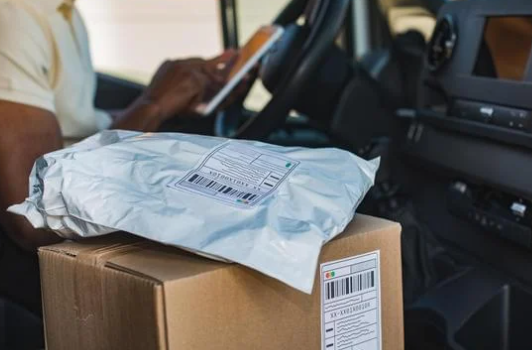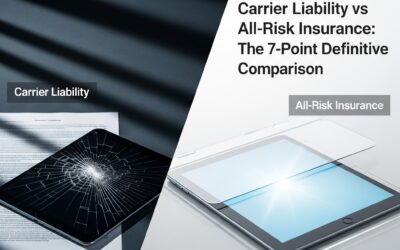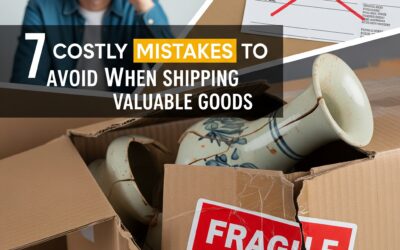Secure Business Success with High-Value Shipping Insurance
When your business depends on sending premium goods to clients or partners, high-value shipping insurance becomes a cornerstone of your risk management strategy. The reality is that shipments can be lost, damaged, or delayed — and without high-value shipping insurance, your company could suffer significant financial loss. From luxury items and tech equipment to rare collectibles and sensitive merchandise, high-value shipping insurance ensures you’re not left vulnerable to the unpredictable nature of logistics.
Incorporating high-value shipping insurance into your operations isn’t just a smart move—it’s a necessity. It demonstrates that your business takes its commitments seriously, values its inventory, and prioritizes client satisfaction. Without high-value shipping insurance, even a single mishap could cost you thousands, or worse, damage your brand’s reputation.
No matter your industry, the cost of replacing high-ticket merchandise can be devastating. By leveraging high-value shipping insurance, businesses can recover faster, maintain trust with clients, and keep operations running smoothly. Don’t gamble on good fortune alone—high-value shipping insurance puts you in control.
Whether you’re shipping luxury fashion, electronics, or custom-made machinery, high-value shipping insurance protects your business from setbacks. It acts as a financial shield and reputation preserver, ensuring your brand delivers confidence with every package.

7 Reasons to Invest in High-Value Shipping Insurance for Business
Investing in high-value shipping insurance is one of the smartest decisions a business can make when dealing with expensive or sensitive goods. It not only mitigates risk—it empowers you to scale with confidence, deliver better service, and protect your brand integrity.
1. Financial Security and Full Reimbursement
The most obvious and critical benefit of high-value shipping insurance is financial protection. If your shipment is lost, stolen, or damaged during transit, you won’t bear the burden alone. Insurance ensures full or partial reimbursement for the declared value of the goods. This safeguards your bottom line and allows you to confidently replace or refund the customer without taking a loss.
2. Enhanced Customer Satisfaction and Trust
Customers expect reliability, especially when purchasing high-priced items. Offering high-value shipping insurance shows you’re serious about safeguarding their investment. It builds trust and elevates the buyer experience. When clients know their goods are insured, they feel more secure—reducing pre-delivery anxiety and post-purchase concerns. This confidence translates into repeat business, better reviews, and more referrals.
3. Protection Against Carrier Limitations
Most major shipping carriers offer only basic or minimal coverage, often capped at $100, and rarely tailored for high-value shipments. By choosing high-value shipping insurance, you overcome these limitations. You’re no longer bound by restrictive carrier rules or low payout caps. You gain access to faster claims processing, broader coverage terms, and better support in the event of a problem.
4. Global Coverage for International Shipments
Cross-border shipping presents unique risks—from customs delays to theft and rough handling. High-value shipping insurance extends peace of mind across borders. Whether you’re shipping from Canada to the U.S. or exporting to Europe or Asia, your goods are protected every step of the way. This makes international expansion less daunting and gives you a competitive edge in global commerce.
5. Brand Reputation and Professionalism
Offering high-value shipping insurance is a mark of professionalism. It communicates to clients and partners that your business is detail-oriented, customer-first, and prepared. It helps position you as a premium provider that values accountability and reliability. In a crowded market, these signals matter and can help you stand out.
6. Streamlined Claims and Peace of Mind
Dealing with damaged or missing shipments can be exhausting—especially without coverage. With high-value shipping insurance, the claims process is often faster, more transparent, and well-documented. This reduces stress on your team, helps you manage disputes efficiently, and gives you peace of mind every time a parcel leaves your facility.
7. Flexible Coverage Tailored to Your Business
Many insurance providers offer flexible options based on your specific needs—whether you ship luxury fashion, electronics, fine art, or collectibles. This tailored approach ensures your high-value shipping insurance is aligned with your risk profile and operational volume, helping you optimize costs while maximizing protection.
Summary:
The advantages of investing in high-value shipping insurance are substantial. From securing your revenue and enhancing customer trust to navigating carrier limits and expanding globally, this protective layer empowers your business to grow without unnecessary risk. It’s not just an expense—it’s an investment in operational resilience and brand strength.

Risks of Not Having High-Value Shipping Insurance
Shipping without high-value shipping insurance can expose your business to major financial and reputational damage. Below are the key risks you face when you opt to skip this essential layer of protection.
1. Complete Financial Loss
Without high-value shipping insurance, your business bears the full cost of any lost, stolen, or damaged item. If a $10,000 shipment is never delivered or arrives destroyed, you absorb that expense entirely. Standard carrier liability typically caps out at $100 or less—nowhere near the value of the shipment. Over time, these losses can add up, turning a profitable business into a struggling one. In industries dealing with rare, irreplaceable, or high-ticket items, even one incident can be financially devastating.
2. Irreversible Customer Trust Issues
Clients expect timely and secure delivery—especially when they’re paying for high-end items. If you can’t replace or reimburse a damaged product because you lacked high-value shipping insurance, that trust breaks instantly. Customers may leave negative reviews, demand refunds, or worse—discontinue doing business with you. In today’s hyperconnected world, one bad experience can snowball, harming your brand’s reputation across platforms.
3. No Recourse Against Carrier Errors
Even trusted shipping carriers occasionally mishandle parcels. Unfortunately, their liability limits are low, and many exclude specific high-value items from full coverage. If you rely solely on their basic coverage without purchasing high-value shipping insurance, you may find that even clear-cut claims are denied or underpaid. This leaves you with few options to recover your losses and puts your business in a reactive, rather than proactive, position.
4. Limited Coverage for International Shipments
Global shipping comes with unique risks: customs delays, theft, misrouting, and longer transit times. Standard shipping coverage typically doesn’t provide robust international protections. Without high-value shipping insurance, your overseas shipments are vulnerable. Whether you’re selling to an international client or sending goods to a warehouse abroad, the cost of unprotected loss can be enormous—especially when compounded by customs duties or taxes.
5. Higher Operational Stress and Downtime
When something goes wrong and there’s no high-value shipping insurance to fall back on, business owners are forced to redirect time, energy, and resources toward damage control. This includes customer service disputes, replacement product procurement, supply chain delays, and financial reporting issues. The ripple effect can hurt productivity and slow business momentum, especially for small teams or solo entrepreneurs.
6. Missed Opportunity to Project Professionalism
Providing high-value shipping insurance isn’t just about risk management—it’s also a sign of professionalism. Customers feel safer and more confident when they know a business prioritizes protection. Without it, you risk appearing unprepared or careless. Offering insurance can differentiate your brand, especially in industries where clients expect concierge-level service and white-glove logistics.
7. Potential Legal and Contractual Disputes
If you’re shipping items under contractual agreements—such as with B2B partners or resellers—failing to insure your shipment may violate those terms. This opens your business to legal exposure, penalties, or forced reimbursements that could have been avoided. With high-value shipping insurance, your business demonstrates compliance, diligence, and credibility in contractual dealings.
Summary:
The risks of shipping high-value items without proper insurance are significant and multifaceted. From unrecoverable losses to reputational harm and legal issues, the cost of skipping high-value shipping insurance far outweighs the investment required to secure it. For businesses seeking long-term growth, financial resilience, and customer loyalty, insurance is not optional—it’s strategic.
Best Practices for High-Value Shipping Insurance
Ensuring the safe delivery of expensive, rare, or sensitive goods requires more than just a sturdy box and a signature at delivery. These best practices for high-value shipping insurance help minimize risk, streamline claims, and protect your customer relationships and profits.
1. Assess the True Value of Your Items Before Shipping
Accurate valuation is a foundational step for effective high-value shipping insurance. Always document and assess the real value of each item you ship. Use receipts, appraisals, or invoices to support the declared value, especially for antiques, collectibles, or custom-made goods.
Make sure your insured value reflects the full replacement cost, not just the wholesale or depreciated value. This helps ensure you’re adequately covered in case of total loss or irreparable damage.
High-value shipping insurance is only as effective as the accuracy of your declared amount.
2. Use Industry-Approved Packaging Standards
Packaging is often the determining factor in whether a claim is paid out. Always follow packaging best practices:
- Use double-walled corrugated boxes
- Cushion with at least 2 inches of foam, bubble wrap, or air pillows on all sides
- Wrap each item individually
- Reinforce corners and use shock-absorbent materials for fragile goods
- Choose the smallest box that allows for full padding without cramming
- Click here for tips on how to package your shipment for safe transit
High-value shipping insurance often includes fine print about packaging requirements. Failing to meet them may invalidate your coverage—so treat packaging as seriously as the insurance itself.
3. Document Every Stage with Photos
For every high-value shipment, create a photographic record of the entire packing process:
- Materials used (empty box and padding)
- Each item before wrapping
- Each item after being wrapped
- Placement in the box
- Box before and after sealing
- Final labeled shipment
This documentation is vital for successful claims. If a package arrives damaged and you can prove proper handling on your end, your high-value shipping insurance provider is far more likely to approve and expedite your claim.
4. Choose the Right Shipping Carrier and Service Level
Not all carriers treat high-value packages with the same care. When possible:
- Choose priority services with faster transit times
- Opt for carriers with a strong track record of handling luxury and high-value goods
- Avoid consolidated or economy options that increase touchpoints and transfer risk
Pairing a reliable carrier with comprehensive high-value shipping insurance provides a double layer of security. Always track and require signature confirmation at delivery.
5. Verify the Coverage Scope and Exclusions
Don’t assume that all insurance policies are alike. Review the fine print:
- What events are covered? (Loss, theft, water damage, breakage, etc.)
- Are there coverage exclusions? (Acts of God, improper packing, delays?)
- Is coverage limited by location or carrier choice?
- Are fragile, vintage, or perishable items included or excluded?
Clear understanding of your high-value shipping insurance terms means no surprises later—especially during claims.
6. Insure Shipments at the Time of Booking
Avoid waiting until after a package is dropped off or picked up. To ensure proper risk transfer and avoid rejection:
- Apply high-value shipping insurance at the time of shipment booking
- Confirm the insurance is active and attached to the tracking ID
- Keep confirmation emails and digital receipts
Some policies only activate if attached before shipping begins. Timing matters.
7. Communicate With Customers About Insurance
Inform your clients that you’ve added high-value shipping insurance to their order. This builds trust and helps justify any additional shipping fees. Provide a quick summary of what’s covered and what steps you’ve taken to protect their purchase.
Transparency adds to your brand’s professionalism and shows buyers that you prioritize their investment.
8. Create a Claims Process SOP (Standard Operating Procedure
Even with careful handling, things can go wrong. Prepare in advance:
- Assign a team member or workflow for submitting claims
- Document what information and photos are needed
- Track every step of the process until reimbursement is completed
- Communicate claim timelines to your customer
The faster and smoother your claims process, the less impact it has on customer satisfaction—and the easier it is to recover from losses. Your high-value shipping insurance becomes part of your customer service excellence.
9. Maintain Consistent Records for Audit and Review
Keep digital records of:
- Item invoices and appraisals
- Insurance receipts and policy numbers
- Packing photos and shipment tracking numbers
- Claims correspondence and resolutions
These records will help in cases of disputes or multiple claims. They also allow you to evaluate how well your high-value shipping insurance provider is performing over time.
By integrating these best practices into your shipping SOPs, you can significantly reduce risks, increase claims success, and deliver world-class customer experiences. High-value shipping insurance is a powerful tool—but only when it’s matched with strong internal processes.
Final Thoughts: Is Shipping Insurance Worth It?
In a world where speed, value, and trust are everything, high-value shipping insurance offers an unbeatable advantage. Every shipment you send reflects your business—don’t let loss or damage define your customer’s experience. With high-value shipping insurance, you’re showing clients that you take every step to deliver not only products, but also peace of mind.
Investing in high-value shipping insurance is also an investment in your company’s financial security. It’s a simple decision that pays off with every successful delivery, claim-free resolution, and glowing customer review. That reliability fosters loyalty and positions you as a brand customers can count on.
Beyond damage control, high-value shipping insurance helps you scale with confidence. Whether you’re sending 10 items a month or 10,000, each shipment remains protected. This consistency allows you to grow without the constant anxiety of loss.
In 2025 and beyond, customers expect businesses to go above and beyond. By offering high-value shipping insurance, you deliver assurance, quality, and a customer-first approach that sets your business apart.
Click here to get an instant shipping insurance quote of contact us today for more information.

FAQs
1. What is high-value shipping insurance?
High-value shipping insurance protects expensive items during transit by covering loss, damage, or theft. It goes beyond standard carrier liability, offering businesses the confidence that their most valuable shipments are financially protected.
2. Why is high-value shipping insurance necessary for businesses?
Businesses that ship luxury goods, electronics, or collectibles face greater risk. High-value shipping insurance safeguards revenue and brand trust, ensuring any loss doesn’t impact operations or reputation.
3. What qualifies as a high-value item?
Typically, any item valued over $500 is considered high-value. This includes designer fashion, electronics, art, instruments, and collectibles—items that absolutely require high-value shipping insurance.
4. Does standard carrier coverage include high-value items?
Most carrier policies only cover up to $100. High-value shipping insurance fills this gap with full value reimbursement, specialized handling terms, and stronger claims support.
5. Can high-value shipping protection cover international shipments?
Yes, many policies include international coverage, protecting your goods across borders and customs. Always check the policy terms and destination requirements.
6. How do I document shipments for high-value shipping protection?
Take clear photos of the item before packaging, during packing, and once sealed. Keep receipts and appraisals, and include tracking numbers with your policy.
7. What types of businesses should consider high-value shipping protection?
E-commerce retailers, jewelers, electronics suppliers, galleries, and fashion brands all benefit from high-value shipping insurance due to the value and frequency of their shipments.
8. How much does high-value shipping protection cost?
Costs vary but are typically 1–3% of the item’s declared value. This minor expense offers significant protection compared to the cost of loss or damage.
9. Can I get high-value shipping insurance for one-time shipments?
Yes, many insurers offer per-shipment policies. This is ideal for occasional or high-ticket shipments, such as auctions or rare sales.
10. Will high-value shipping insurance speed up claims?
Absolutely. Specialized insurers are designed to handle claims efficiently—especially for documented high-value shipments—reducing stress and downtime.
11. What happens if I don’t use high-value shipping insurance?
You risk full financial loss, dissatisfied customers, and potential reputational damage. High-value shipping insurance mitigates all these risks and gives your brand a safety net.
12. Is high-value shipping insurance tax-deductible?
In many cases, yes—check with your tax professional. If it’s part of your business expense for operations or shipping, it often qualifies.
Additional Resources:
- Insurance Information Institute
- Small Business Administration – Shipping Tips
- Forbes: Shipping Best Practices
- National Retail Federation
- Business.com: Supply Chain Risk
- Entrepreneur Shipping Resources
- Consumer Reports – Online Shopping Safety
- Investopedia: Shipping Insurance
- Harvard Business Review: Customer Trust
- Retail TouchPoints: Shipping Trends
- Logistics Management News





